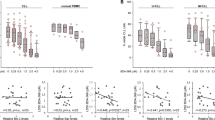Abstract
Chronic myeloid leukemia (CML) is characterized by the presence of p210Bcr-Abl which exhibits an abnormal kinase activity. Selective Abl kinase inhibitors have been successfully established for the treatment of CML. Despite high rates of clinical response, CML patients can develop resistance against these kinase inhibitors mainly due to point mutations within the Abl protein kinase domain. Previously, we have identified oleic acid as the active component in the mushroom Daedalea gibbosa that inhibited the kinase activity of Bcr-Abl. Here, we report that the oleyl amine derivatives, S-1-(1-Hydroxymethyl-2-methyl-propyl)-3-octadec-9-enyl-urea [oleylaminocarbonyl-L-N-valinol,oroleylaminocarbonyl-S-2-isopropyl-N-ethanolamine,oleylamine-carbonyl-L-valinol] (cpd 6) and R-1-(1-Hydroxymethyl-2-methyl-propyl)-3-octadec-9-enyl-urea [oleylamineocarbonyl-D-N-valinol, oleylaminocarbonyl-R-2-isopropyl-N-ethanolamine, or oleylamine-carbonyl-D-valinol] (cpd 7), inhibited the activity of the native and T315I mutated Bcr-Abl. Furthermore, cpd 6 and 7 exhibited higher activity towards the oncogenic Bcr-Abl in comparison to native c-Abl in SupB15 Ph-positive ALL cell line.






Similar content being viewed by others
References
Faderl S, Talpaz M, Estrov Z, Kantarjian HM (1999) Chronic myelogenous leukemia: biology and therapy. Ann Intern Med 131:207–219
el Touny S, Khan W, Hannun Y (1990) Regulation of platelet protein kinase C by oleic acid. Kinetic analysis of allosteric regulation and effects on autophosphorylation, phorbol ester binding, and susceptibility to inhibition. J Biol Chem 265:16437–16443
Faderl S, Talpaz M, Estrov Z, O’Brien S, Kurzrock R et al (1999) The biology of chronic myeloid leukemia. N Engl J Med 341:164–172
Ottmann OG, Hoelzer D (2002) The ABL tyrosine kinase inhibitor STI571 (Glivec) in Philadelphia positive acute lymphoblastic leukemia: promises, pitfalls and possibilities. Hematol J 3:2–6
Sawyers CL, Hochhaus A, Feldman E, Goldman JM, Miller CB et al (2002) Imatinib induces hematologic and cytogenetic responses in patients with chronic myelogenous leukemia in myeloid blast crisis: results of a phase II study. Blood 99:3530–3539
Talpaz M, Silver RT, Druker BJ, Goldman JM, Gambacorti-Passerini C et al (2002) Imatinib induces durable hematologic and cytogenetic responses in patients with accelerated phase chronic myeloid leukemia: results of a phase 2 study. Blood 99:1928–1937
Gambacorti-Passerini CB, Gunby RH, Piazza R, Galietta A, Rostagno R et al (2003) Molecular mechanisms of resistance to imatinib in Philadelphia-chromosome-positive leukaemias. Lancet Oncol 4:75–85
O’Hare T, Corbin AS, Druker BJ (2006) Targeted CML therapy: controlling drug resistance, seeking cure. Curr Opin Genet Dev 16:92–99
Beissert T, Hundertmark A, Kaburova V, Travaglini L, Mian AA et al (2008) Targeting of the N-terminal coiled coil oligomerization interface by a helix-2 peptide inhibits unmutated and imatinib-resistant BCR/ABL. Intern J Cancer 122:2744–2752
Adrian FJ, Ding Q, Sim T, Velentza A, Sloan C et al (2006) Allosteric inhibitors of Bcr-abl-dependent cell proliferation. Nat Chem Biol 2:95–102
Huang WS, Metcalf CA, Sundaramoorthi R, Wang Y, Zou D et al (2012) Discovery of 3-[2-(imidazo[1,2-b]pyridazin-3-yl)ethynyl]-4-methyl-N-{4-[(4-methylpiperazin-1-yl)methyl]-3-(trifluoromethyl)phenyl}benzamide (AP24534), a potent, orally active pan-inhibitor of breakpoint cluster region-abelson (BCR-ABL) kinase including the T315I gatekeeper mutant. J Med Chem 53:4701–4719
O’Hare T, Shakespeare WC, Zhu X, Eide CA, Rivera VM et al (2009) AP24534, a pan-BCR-ABL inhibitor for chronic myeloid leukemia, potently inhibits the T315I mutant and overcomes mutation-based resistance. Cancer Cell 16:401–412
Zhou T, Commodore L, Huang WS, Wang Y, Thomas M et al (2012) Structural mechanism of the Pan-BCR-ABL inhibitor ponatinib (AP24534): lessons for overcoming kinase inhibitor resistance. Chem Biol Drug Des 77:1–11
Yassin M, Mahajna JA (2003) Medicinal mushroom extracts selectively inhibit proliferation and induce differentiation of K562 Human Chronic Myelogenous Leukemia blast cells. Int J Med Mushroom 5:259–274
Yassin M, Wasser SP, Mahajna J (2008) Substances from the medicinal mushroom Daedalea gibbosa inhibit kinase activity of native and T315I mutated Bcr-Abl. Int J Oncol 32:1197–1204
Khamaisie H, Sussan S, Tal M, Najajreh Y, Ruthardt M et al (2012) Oleic acid is the active component in the mushroom Daedalea gibbosa inhibiting Bcr-Abl kinase autophosphorylation activity. Anticancer Res 31:177–183
Zhang J, Adrian FJ, Jahnke W, Cowan-Jacob SW, Li AG, et al Targeting Bcr-Abl by combining allosteric with ATP-binding-site inhibitors. Nature 463: 501–506
Schenkel LB, Huang X, Cheng A, Deak HL, Doherty E et al (2011) Discovery of potent and highly selective thienopyridine Janus kinase 2 inhibitors. J Med Chem 54:8440–8450
Morris GM, Goodsell DS, Halliday RS, Huey R, Hart WE et al (1998) Automated docking using a Lamarckian genetic algorithm and an empirical binding free energy function. J Comput Chem 19:1639–1662
Goodsell DS, Morris GM, Olson AJ (1996) Automated docking of flexible ligands: applications of autoDock. J Mol Recognit 9:1–5
Choi Y, Seeliger MA, Panjarian SB, Kim H, Deng X et al (2009) N-myristoylated c-Abl tyrosine kinase localizes to the endoplasmic reticulum upon binding to an allosteric inhibitor. J Biol Chem 284:29005–29014
Carey KD, Garton AJ, Romero MS, Kahler J, Thomson S et al (2006) Kinetic analysis of epidermal growth factor receptor somatic mutant proteins shows increased sensitivity to the epidermal growth factor receptor tyrosine kinase inhibitor, erlotinib. Cancer Res 66:8163–8171
Luke JJ, Hodi FS (2012) Vemurafenib and BRAF inhibition: a new class of treatment for metastatic melanoma. Clin Cancer Res 18:9–14
Khateb M, Ruimi N, Khamisie H, Najajreh Y, Mian A, Metodieva A, Ruthardt M, Mahajna J (2012) Overcoming Bcr-Abl T315I mutation by combination of GNF-2 and ATP competitors in an Abl-independent mechanism. BMC Cancer 12(1):563. doi:10.1186/1471-2407-12-563
Acknowledgments
This work was supported, in part, by DFG-RU 728/3-2 to MR, YN and JM.
Author information
Authors and Affiliations
Corresponding author
Rights and permissions
About this article
Cite this article
Najajreh, Y., Khamaisie, H., Ruimi, N. et al. Oleylamine-carbonyl-valinol inhibits auto-phosphorylation activity of native and T315I mutated Bcr-Abl, and exhibits selectivity towards oncogenic Bcr-Abl in SupB15 ALL cell lines. Mol Biol Rep 40, 2205–2213 (2013). https://doi.org/10.1007/s11033-012-2282-8
Received:
Accepted:
Published:
Issue Date:
DOI: https://doi.org/10.1007/s11033-012-2282-8




